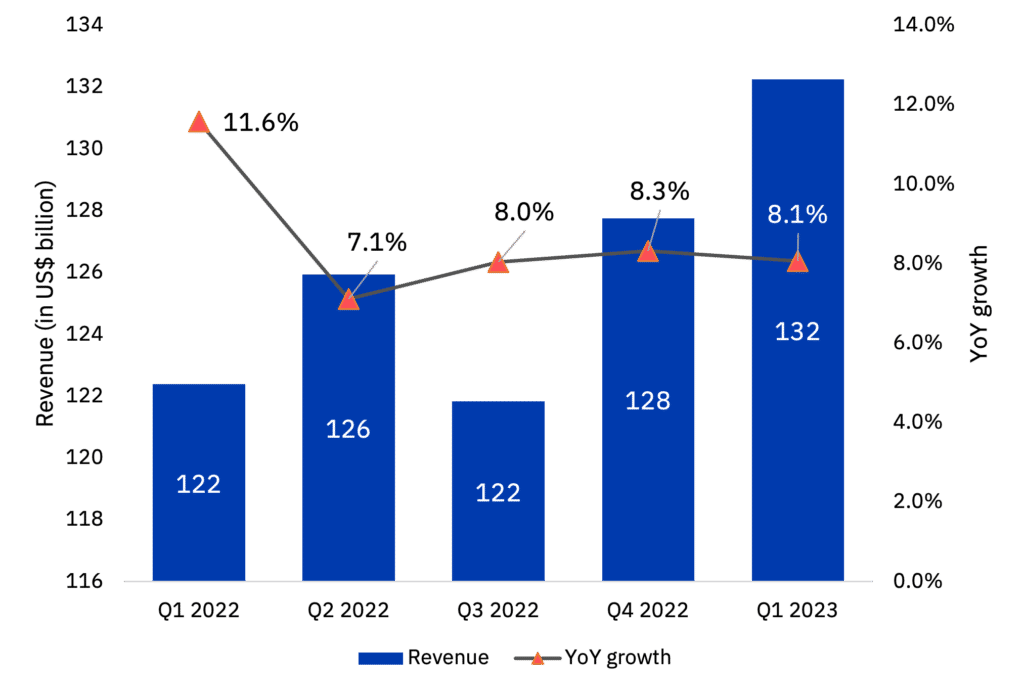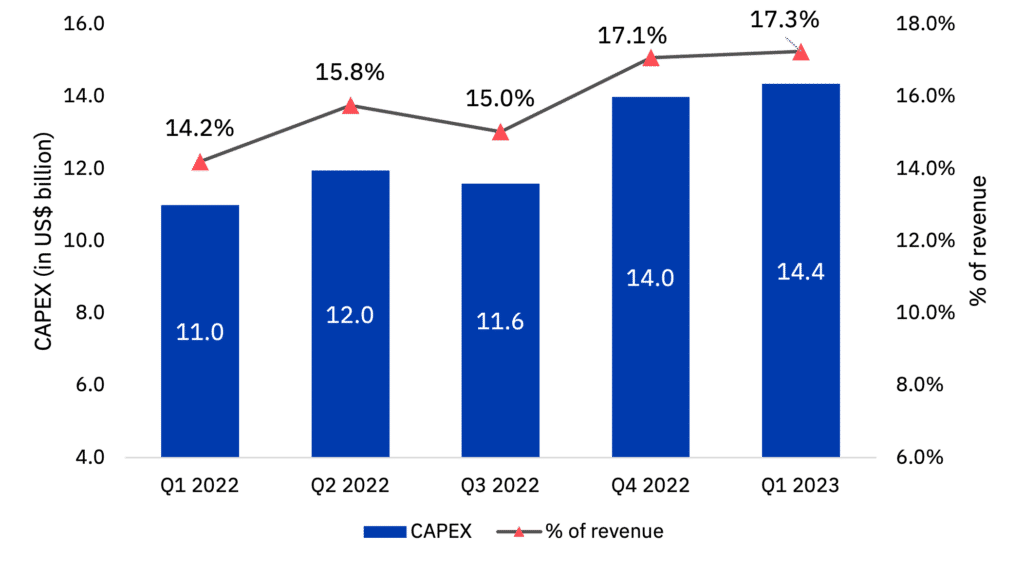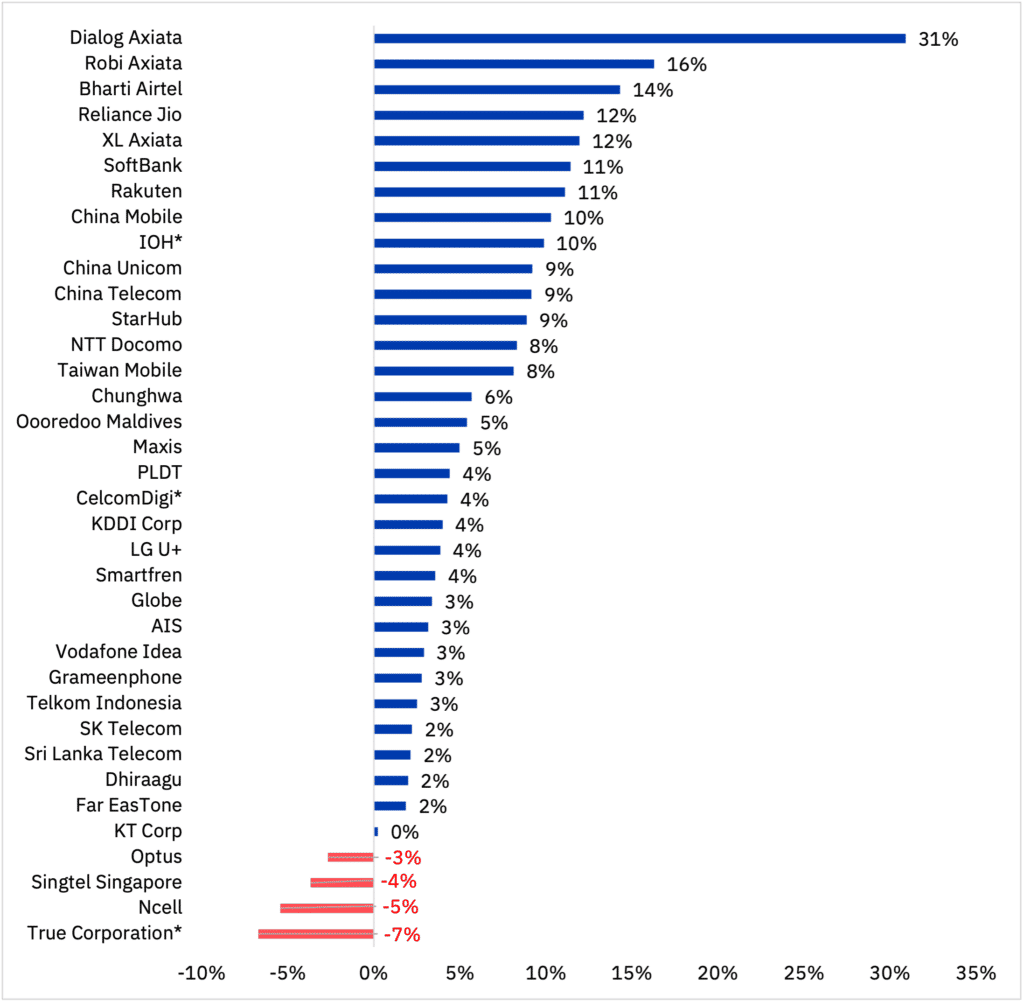Key takeaways
- APAC telcos maintained a robust growth trajectory, as their combined revenue surged by 8.1 percent in Q1 2023. Notably, a significant majority of telcos (89 percent) recorded positive revenue growth during this period.
Exhibit 1
Revenue performance of APAC telcos

*Note: IOH, CelcomDigi, and True Corporation Q1 2022 results are considered on a pro forma basis.
- Telcos in saturated 5G markets such as China and Japan demonstrated significant revenue growth, with Chinese and Japanese telcos witnessing 10 percent and 8 percent revenue growth, respectively. In comparison, South Korean telcos achieved a more modest combined revenue growth of 2 percent YoY.
- Indian telcos collectively experienced a significant YoY growth of 12 percent, with Bharti Airtel and Reliance Jio leading the industry with 14 percent and 12 percent respectively.
- In Q1 2023, telcos in APAC achieved an average EBITDA margin of 29.5 percent. Impressively, 17 percent of these telcos surpassed a remarkable 50 percent margin during the same period.
Exhibit 2
Combined EBITDA margin change for APAC telcos

*Note: IOH, CelcomDigi, and True Corporation Q1 2022 results are considered on a pro forma basis.
- Far Eastone experienced a remarkable increase in EBITDA margin, growing by 740 basis points year over YoY, while Grameenphone achieved the highest EBITDA margin among telcos, reaching an impressive 61.1 percent in Q1 2023, with a notable increase of 300 basis points.
- CAPEX for APAC telcos grew by 30.5 percent YoY to reach US$ 14.4 billion. As a result, CAPEX as a percentage of revenue increased from 14.2 percent in Q1 2022 to 17.3 percent in Q1 2023.
Exhibit 3
CAPEX performance of APAC telcos

*Note: IOH, CelcomDigi, and True Corporation Q1 2022 results are considered on a pro forma basis.
- Emerging economies like India and Bangladesh have experienced a significant increase in Average Revenue Per User (ARPU) due to strategic initiatives implemented by telcos. In India, telcos made tariff adjustments, resulting in an uplift in ARPU. Similarly, in Bangladesh, telcos witnessed a remarkable 22 percent growth in data usage, contributing to the rise in ARPU.
APAC telcos continued a strong growth trajectory growing at 8.1 percent in Q1 2023
- In Q1 2023, Axiata group demonstrated strong financial performance, showcasing the resilience and growth potential among telcos in APAC.
- Dialog Axiata achieved an exceptional growth rate of 31 percent YoY, solidifying its position as the frontrunner. This growth was fuelled by market-driven tariff increments, resulting in growth across all three segments—mobile, fixed, and TV. Additionally, their international revenue exhibited growth.
- Despite facing macroeconomic challenges that hindered growth, Robi Axiata managed to achieve a 16 percent YoY, driven by strategic decisions taken on providing consumer-centric offerings that resulted in increased Voice and data revenue.
- XL Axiata reported a 12 percent YoY increase in revenue, primarily driven by data and digital service revenues, which accounted for approximately 91.5 percent of their total revenue.
- Indian telcos collectively witnessed a substantial YoY growth of 12 percent. Going forward, leading Indian telcos expect to sustain a steady growth trajectory, projecting a moderate growth rate of approximately 10 percent throughout the entirety of 2023.
- Among the industry leaders, Bharti Airtel and Reliance Jio outperformed with significant increases of 14 percent and 12 percent, respectively. This growth can be attributed to the continuous addition of 4G customers and an increase in average revenue per user (ARPU).
- However, Vodafone Idea reported marginal growth of 3 percent, primarily due to the loss of subscribers.
- In saturated 5G markets like China and Japan, there was notable combined revenue growth of 10 percent and 8 percent, respectively.
- Chinese telcos achieved this growth by successfully implementing comprehensive cloudification and digital transformation strategies, which contributed to their overall revenue increase.
- NTT Docomo’s revenue growth was driven by the expansion of their offerings in the others category (including Real Estate, Energy, and others) and system integration services.
- Softbank revenue growth was driven by the increased adoption of Internet of Things (IoT) devices and the implementation of higher royalty rates in the smartphone market.
- Rakuten experienced substantial growth primarily within the FinTech and Mobile segments.
- True Corporation, Singtel Singapore, Ncell, and Optus reported a decline in revenue during Q1 2023.
- True Corporation experienced a decline in revenue due to a revised wholesale arrangement with DTAC and a reduced contribution from its Mobile and online segments.
- Optus reported a decline in performance attributed to lower NBN migration payments, reduced equipment sales, and the cessation of leasing revenues. The conclusion of NBN migration revenues in the quarter will no longer impact Optus’ revenue beyond Q1 2023.
- Singtel’s consumer business in Singapore showed positive momentum, driven by increased mobile service revenue, particularly from higher roaming usage, increased adoption of 5G, and growth in prepaid sales. However, this growth was insufficient to offset the overall decline in the business.
- Ncell’s decline was primarily impacted by lower interconnection rates and minutes of usage (MoU).
Exhibit 4
Percent revenue change for APAC telcos, Q1 2023

*Note: IOH, CelcomDigi and True Corporation Q1 2022 results are considered on a pro forma basis.
APAC telcos achieved an average EBITDA margin of 29.5 percent
- Telcos experienced a moderate decline of 140 basis points YoY in their average EBITDA margin, which stood at 29.5 percent in Q1 2023
- 34 percent of telcos covered in the analysis experienced an uptick in EBITDA margin. Notably, Far EasTone and Singtel Singapore achieved significant EBITDA margin increases exceeding 500 basis points.
- Far Eastone experienced an increase of 740 basis points in its EBITDA margin. This growth was driven by higher service revenue.
- Singapore witnessed 630 basis points increase in EBITDA margin to 24 percent in Q1 2023. EBITDA margin improvement for Singtel was driven by increased fixed broadband revenue on the back of higher-speed broadband plans.
- Despite the challenging macroeconomic environment marked by inflation, energy price hikes, and diminishing foreign exchange reserves, Bangladesh telcos reported a marginal increase in EBITDA margin.
- Grameenphone achieved the highest EBITDA margin of 61.1 percent among APAC telcos in Q1 2023 with an increase of 300 basis points in its EBITDA margin. This exceptional performance was driven by both revenue growth and enhanced operational efficiency.
- Robi Axiata EBITDA margin grew by 260 basis points to 44.8 percent.
- Indian telcos Bharti Airtel and Reliance Jio continued to have a healthy EBITA margin above 50 percent, while Vodafone Idea EBITDA margin declined by 540 basis points to 40 percent.
- Telekom Indonesia and Ncell successfully maintained an EBITDA margin above 50 percent, even though they experienced a decrease of 240 and 140 basis points respectively.
- Dialog Axiata, Globe, Softbank, and Vodafone Idea were major telcos that witnessed a significant decline in EBITDA margins in Q1 2023.
- Dialog Axiata witnessed a decline in their EBITDA margin, which decreased by 2180 basis points to 16.6 percent. This was primarily due to higher direct and network costs resulting from double-digit inflation, further compounded by an increase in depreciation and amortization expenses.
Exhibit 5
EBITDA performance, Q1 2023

*Note: IOH, CelcomDigi and True Corporation Q1 2022 results are considered on a pro forma basis.
Strategic investments: APAC telcos allocate 17.3 percent of revenue as CAPEX in Q1 2023
- Telcos in the APAC region showcased their commitment to growth by spending 17.3 percent of their revenue as CAPEX, amounting to an impressive US$ 14.4 billion in Q1 2023.
- Bharti Airtel achieved remarkable YoY CAPEX growth rates of 110 percent. This substantial increase can be attributed to their proactive approach in deploying 5G technology, demonstrating their commitment to technological advancement and expansion.
- In Bangladesh, the telecom industry also witnessed impressive year-on-year CAPEX growth, aligning with their strategic investments to improve mobile penetration throughout the country.
- Robi Axiata and Grameenphone reported significant CAPEX spending increases of 101 percent and 77 percent, respectively, reflecting their dedication to enhancing their network infrastructure and services.
- China Telecom emerged as a leader with a significant CAPEX investment of US$ 4.5 billion, primarily directed towards industrial digitalization. They have plans to further increase their spending by 40 percent by 2023.
- Philippine telcos allocated over 35% of revenues towards CAPEX to drive the expansion of cell sites and fibre networks.
- PLDT and Globe dedicated 37% and 39% of their respective revenues towards CAPEX initiatives, despite the resulting increase in debt and potential strain on credit metrics.
- Dialog Axiata, CelcomDigi, Rakuten, and Vodafone Idea were major telcos that witnessed a significant decline in CAPEX investment in Q1 2023.
- Vodafone Idea reported a decline of 54 percent in CAPEX spending as they have not started the rollout of 5G. However, they have planned to increase their CAPEX to 9 percent of its revenue to reach US$ 403 million in 2023.
- CelcomDigi strategically reduced their CAPEX spending by 54 percent as they are monitoring the CAPEX allocation by focusing on network and IT integration initiatives. They aim to allocate 15-18 percent of their revenue to CAPEX in 2023.
- Rakuten’s CAPEX decline is part of a reduction plan for 2023-2025, designed to accelerate their path to profitability.
- Despite achieving substantial revenue growth, Dialog Axiata experienced a drop in CAPEX, mainly due to a stable exchange rate and a decrease in spending, indicating their efficient allocation of resources.
Exhibit 6
CAPEX performance, Q1 2023

*Note: IOH, CelcomDigi and True Corporation Q1 2022 results are considered on a pro forma basis.
Strategic measures propel Telcos’ ARPU to new heights
- Countries with large and growing economies, such as India and Bangladesh, have experienced notable growth in Average Revenue Per User (ARPU) due to strategic measures undertaken by telcos.
- In India, telcos implemented tariff adjustments, leading to an elevation in ARPU. Indian telcos have set ambitious targets to raise their ARPU to INR 250 (US$ 3.1) by 2025, reflecting their focus on driving revenue growth and capturing the value of their services.
- Similarly, in Bangladesh, telcos made substantial investments in expanding their network infrastructure and deploying new spectrum, resulting in a commendable 22 percent growth in data usage, which subsequently increased their ARPU.
- Softbank, KDDI Corp, Ncell, and AIS experienced a decline in ARPU during the current quarter.
- Japanese telcos have witnessed a decline in ARPU as they reached peak penetration and are now operating in a saturated environment, leading to a shift in their ARPU trends. However, hey anticipate stabilization in the upcoming quarters.
- Decline in mobile service revenue due to lower interconnection rates and minutes of usage (MoU), Ncell faced a decline in ARPU.
- AIS experienced a decline in ARPU due to ongoing price competition, particularly in the low-cost unlimited data segment. However, the company anticipates ARPU growth in 2023 as the adoption of 5G services gains momentum, presenting opportunities for revenue enhancement.
Exhibit 7
ARPU performance, Q1 2023

*Note: IOH, CelcomDigi and True Corporation Q1 2022 results are considered on a pro forma basis.
Thank you for reading! Reach out to us for any feedback
You might also like:
Benchmarking the performance of the top 5 telecom equipment vendors in Q1 2023
Cloud Stories Q1 2023: Insights into the performance of AWS, MIC, GCP and Oracle Cloud








